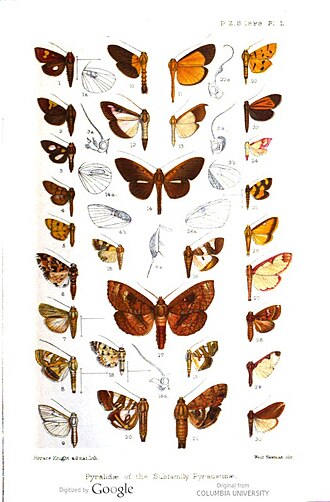Pyralidae




Pyralidae is a family of moths in the order Lepidoptera, which is known for its diversity and worldwide distribution. The family Pyralidae, commonly referred to as pyralid moths or snout moths, encompasses a wide range of species, many of which are significant in various ecological roles as well as in agriculture, both as pests and beneficial insects.
Description[edit]
Pyralidae moths are characterized by their diverse sizes and appearances, but most share some common morphological features such as a well-developed proboscis, scaled wings, and a distinctive resting posture where the wings are held flat over the body or slightly roof-shaped. The wing span of these moths can range from very small to medium size. Many species have brightly colored or patterned wings, although others are more drab, which helps in camouflage or warning predators of their toxicity.
Life Cycle[edit]
The life cycle of pyralid moths follows the complete metamorphosis pattern typical of Lepidoptera, progressing through egg, larva (caterpillar), pupa, and adult stages. The larvae of many species are known as leaf rollers, borers, or miners, and they feed on a wide variety of plant materials, including leaves, stems, fruits, and seeds. Some species are adapted to aquatic environments and have larvae that can live underwater.
Ecological Role[edit]
Pyralidae moths play significant ecological roles. Many species are pollinators, while their larvae serve as a food source for various predators, including birds, bats, and other insects. However, some species are considered pests in agriculture and horticulture, as their larvae can cause significant damage to crops, stored grain, and other stored products.
Economic Importance[edit]
Several species within the Pyralidae family are of considerable economic importance. For example, the Indianmeal moth (Plodia interpunctella) is a well-known pest of stored grains and food products. On the other hand, some pyralid moths are used in biological control programs to manage invasive aquatic plants.
Taxonomy and Classification[edit]
The family Pyralidae has historically been divided into several subfamilies, although the exact classification has been subject to revision as molecular phylogenetic studies provide new insights into the relationships within this group. The family is part of the superfamily Pyraloidea, which also includes the closely related Crambidae family, often referred to as the grass moths.
Conservation[edit]
While many species of Pyralidae are common and not of conservation concern, habitat loss and pollution have led to declines in some populations. Conservation efforts for moths and other insects are increasingly recognized as important for maintaining biodiversity and ecosystem health.
Ad. Transform your life with W8MD's Budget GLP-1 injections from $75


W8MD offers a medical weight loss program to lose weight in Philadelphia. Our physician-supervised medical weight loss provides:
- Weight loss injections in NYC (generic and brand names):
- Zepbound / Mounjaro, Wegovy / Ozempic, Saxenda
- Most insurances accepted or discounted self-pay rates. We will obtain insurance prior authorizations if needed.
- Generic GLP1 weight loss injections from $75 for the starting dose.
- Also offer prescription weight loss medications including Phentermine, Qsymia, Diethylpropion, Contrave etc.
NYC weight loss doctor appointmentsNYC weight loss doctor appointments
Start your NYC weight loss journey today at our NYC medical weight loss and Philadelphia medical weight loss clinics.
- Call 718-946-5500 to lose weight in NYC or for medical weight loss in Philadelphia 215-676-2334.
- Tags:NYC medical weight loss, Philadelphia lose weight Zepbound NYC, Budget GLP1 weight loss injections, Wegovy Philadelphia, Wegovy NYC, Philadelphia medical weight loss, Brookly weight loss and Wegovy NYC
|
WikiMD's Wellness Encyclopedia |
| Let Food Be Thy Medicine Medicine Thy Food - Hippocrates |
Medical Disclaimer: WikiMD is not a substitute for professional medical advice. The information on WikiMD is provided as an information resource only, may be incorrect, outdated or misleading, and is not to be used or relied on for any diagnostic or treatment purposes. Please consult your health care provider before making any healthcare decisions or for guidance about a specific medical condition. WikiMD expressly disclaims responsibility, and shall have no liability, for any damages, loss, injury, or liability whatsoever suffered as a result of your reliance on the information contained in this site. By visiting this site you agree to the foregoing terms and conditions, which may from time to time be changed or supplemented by WikiMD. If you do not agree to the foregoing terms and conditions, you should not enter or use this site. See full disclaimer.
Credits:Most images are courtesy of Wikimedia commons, and templates, categories Wikipedia, licensed under CC BY SA or similar.
Translate this page: - East Asian
中文,
日本,
한국어,
South Asian
हिन्दी,
தமிழ்,
తెలుగు,
Urdu,
ಕನ್ನಡ,
Southeast Asian
Indonesian,
Vietnamese,
Thai,
မြန်မာဘာသာ,
বাংলা
European
español,
Deutsch,
français,
Greek,
português do Brasil,
polski,
română,
русский,
Nederlands,
norsk,
svenska,
suomi,
Italian
Middle Eastern & African
عربى,
Turkish,
Persian,
Hebrew,
Afrikaans,
isiZulu,
Kiswahili,
Other
Bulgarian,
Hungarian,
Czech,
Swedish,
മലയാളം,
मराठी,
ਪੰਜਾਬੀ,
ગુજરાતી,
Portuguese,
Ukrainian
